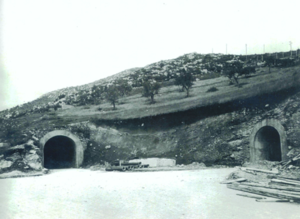| This article needs additional citations for verification. Please help improve this article by adding citations to reliable sources. Unsourced material may be challenged and removed. Find sources: "Soratte Bunker" – news · newspapers · books · scholar · JSTOR (March 2023) (Learn how and when to remove this message) |
| Soratte Bunker | |
|---|---|
| Gallerie del monte Soratte | |
 Early 1940s photo of entrances to the Soratte Bunker Early 1940s photo of entrances to the Soratte Bunker | |
 | |
| General information | |
| Town or city | Metropolitan City of Rome |
| Country | Kingdom of Italy |
| Coordinates | 42°15′N 12°30′E / 42.250°N 12.500°E / 42.250; 12.500 |
| Elevation | 691 m.a.s.l. |
| Construction started | 1937 |
| Completed | 1943 |
| Owner | Fascist Italy |
| Technical details | |
| Material | Concrete, steel, deep excavation |
| Website | |
| Official website | |
The Soratte Bunker is an air raid shelter located under Monte Soratte near Rome, Italy. It was part of a subterranean bunker complex constructed between 1937 and 1943. It was the Headquarters used by Generalfeldmarschall Albert Kesselring from September 1943 to June 1944.
Construction
In the late 1930s, the Italian government commissioned a network of underground galleries and anti-aircraft bunkers under Monte Soratte, about 45 km (28 mi) north of Rome.
Secret excavation work began in 1937 to build a huge air-raid shelter intended to house the Italian government and Comando Supremo should Rome come under siege. The works were conducted by direction of Military Engineering Corps of Rome. Over 4.5 km of underground tunnels were dug into the bowels of the Mountain. The tunnels were reinforced with a layer of cement up to two metres thick and they extended to a depth of over 300 meters (985 feet) underground. The bunker occupied almost 500,000 cubic yards. It had its own water supply, a heating system, electric generator, sewers, radio communications, dormitories, kitchens, storerooms and arms deposits. The complex was initially to spread along 14 km (9 mi) of galleries deep under the mountain, but the work was never completed because of the Italian capitulation.
After the 8 September 1943 Frascati air raid, the extensive bunker became the headquarters of the German occupying forces commanded by Generalfeldmarschall Albert Kesselring.
In the 1950s, the Italian Ministry of Defence used the bunker as a powder magazine before abandoning it in 1962. In the 1960s, during the years of Cold War, the bunker was turned into a fallout shelter for the Italian government and President in case of a nuclear attack on Rome. It would have housed 50 members of the government and 50 NATO technicians. Work on the construction of the atomic bunker began in 1967 and lasted until 1972. In 1989 the bunker fell into disuse. It was kept secret until 2008. Soratte underground network can now be visited.
Decauville railway
On 9 November 2024, an electric Decauville Railway was put into operation in the Monte Soratte bunker, allowing visitors to tour 2.5 km of the previously inaccessible tunnels. The train can also be used independently of the normal tour. What is unusual is that it is a faithful reconstruction of what actually happened here in the mountain. State-of-the-art virtual reality technology is used to recreate history by visualising the bombing of Monte Soratte during the Second World War.
The project was brought to life thanks to many years of effective cooperation between the municipality of Santoreste and the Soratte Bunker Association, which manages the site and looks after the bunker complex. It is now possible to visit the tunnel complex on a narrow-gauge railway, which has been constructed in a modern design that complies with current regulations and can be used by the elderly and children like a fairground ride.
Notes
- ^ "Le gallerie del monte Soratte". 19 April 2012.
- ^ Longo, Luca (27 December 2018). "Il bunker segreto alle porte di Roma: quando i politici italiani giocavano alla guerra nucleare globale". Linkiesta.
- Rosi, Alessandro (16 August 2022). "Bunker Soratte, i segreti del rifugio più grande d'Europa". Il Mattino.
- Owen, Richard (5 August 2003). "Italians open Nazi bunker to tourists". The Times. Retrieved 26 July 2011.
- "The Bunker of the Monte Soratte" (in Italian). L'Associazione Bunker Soratte. Retrieved 26 July 2011.
- Il trenino nel Bunker Soratte.
Gallery
-
 One of the galleries of Soratte bunker
One of the galleries of Soratte bunker
-
 Planimetry in entrance gallery
Planimetry in entrance gallery
-
 Soratte Bunker's entrance
Soratte Bunker's entrance
-
 Soratte fallout shelter's blast door est
Soratte fallout shelter's blast door est
Bibliography
- Paolucci, Gregory; Lo Gaglio, Giuseppe (2013). Il bunker del Soratte - Una montagna di storia. Bunker Soratte. ISBN 978-88-909450-0-7.
- Pugnaletto, Marina; Paolini, Cesira (2019). "Il bunker antiatomico del monte Soratte". Sustainable Mediterranean Construction (1): 421–426. ISSN 2420-8213.
External links
This World War II article is a stub. You can help Misplaced Pages by expanding it. |
This article about an Italian building or structure is a stub. You can help Misplaced Pages by expanding it. |